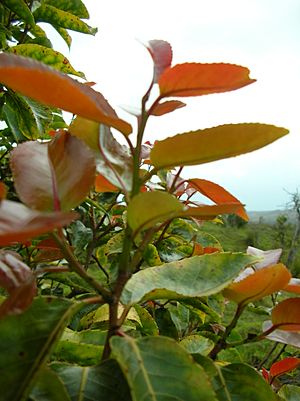Hawai'i brushholly facts for kids
Quick facts for kids Hawai'i brushholly |
|
|---|---|
 |
|
| Scientific classification | |
| Genus: |
Xylosma
|
| Species: |
hawaiensis
|
| Synonyms | |
|
Drypetes forbesii Sherff. |
|
The Xylosma hawaiensis is a special type of flowering plant that belongs to the Salicaceae family. It is found only in Hawaii, meaning it is endemic there. People in Hawaii call this plant by several names, including Hawai'i brushholly, maua, and on the island of Maui, it's also known as aʻe.
What it Looks Like
The Xylosma hawaiensis is a small deciduous tree, which means it loses its leaves every year. It can grow to be about 3 to 9 meters tall (around 10 to 30 feet).
Its leaves are oval-shaped and grow in an alternating pattern along the branches. Each leaf is about 5 to 10 centimeters (2 to 4 inches) long and 3 to 7.5 centimeters (1 to 3 inches) wide. They are attached to the branch by thin stems called petioles, which are about 1 to 2 centimeters (0.4 to 0.8 inches) long.
When the leaves are young, they can be bronze-green, reddish, or even copper-colored with red veins. As they get older, the top side becomes a shiny dark green, and the bottom side is a slightly shiny green. The young twigs are dark red, and they turn dark brown as they mature.
This tree produces small clusters of flowers, called racemes, which are about 1.3 to 2.5 centimeters (0.5 to 1 inch) long. These flowers grow where new leaves start or on the back of older leaves. The flowers are greenish or reddish and about 6 millimeters (0.2 inches) across.
Xylosma hawaiensis trees are dioecious, which means there are separate male and female plants. The female plants produce many small, round fruits called berries during the summer and fall. When these berries are ripe, they turn a deep red color and are about 1 centimeter (0.4 inches) in diameter.
Where it Lives
The maua tree grows in different types of forests in Hawaii. You can find it in dry forests, mixed mesic forests (which are moderately wet), and sometimes even in wet forests. It usually grows at elevations from about 400 to 1220 meters high (around 1,300 to 4,000 feet).
See also
 In Spanish: Xylosma hawaiiensis para niños
In Spanish: Xylosma hawaiiensis para niños

